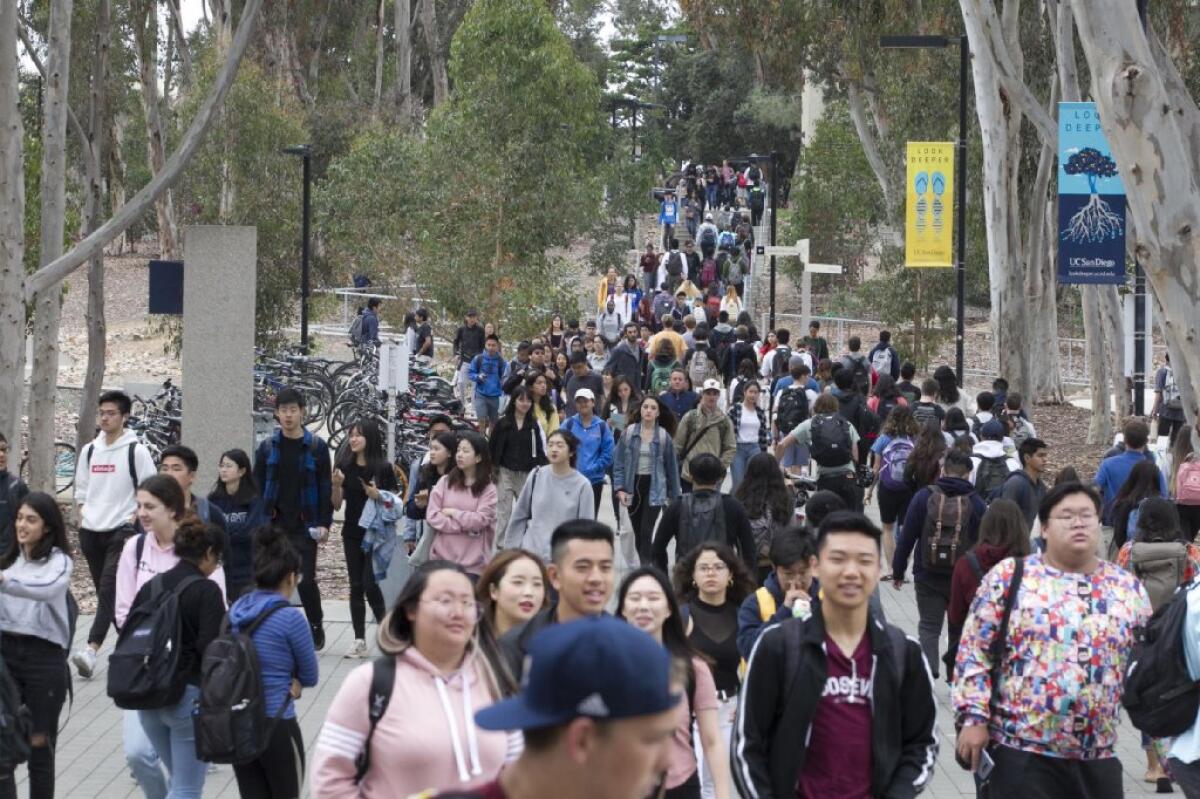How the pandemic unfairly saddled low-income California college students with debt

- Share via
As if remote learning, quarantines and sick family members were not enough, hundreds of thousands of California’s most financially vulnerable college students now face an additional challenge: surprise debts owed to their community colleges and public universities.
When growing numbers of low-income students left college in the middle of the school year during the pandemic, their financial aid awards became “institutional debts” owed and due for payment to their schools effective immediately.
Some California community colleges and Cal State universities wisely canceled these institutional debts. But most, including University of California campuses, publicly report that students with institutional debts can be barred from re-enrolling until their unexpected debt is paid, and some schools have even sent debt collectors after these students.
If this sounds crazy, that’s because it is. California lawmakers and the leaders of public colleges and universities should take action to cancel these debts and fix the financial aid policies that created this problem.
Here is how it works. Most low-income students receive a federal grant to help cover the cost of college. Federal Pell Grants are generally awarded to students whose families make $30,000 a year or less. In California, Pell Grants are commonly disbursed as cash to students for room and board, after state financial aid pays for tuition. If a low-income student is forced to withdraw from school after a month of classes, the student’s college has historically been expected to repay a prorated amount of the Pell Grant to the federal government for the time the student is no longer enrolled.
Schools then typically bill the student for that amount. Students are expected to repay this debt immediately, even if, for instance, they have already used all of their Pell Grant funds to pay for housing for the semester.
These institutional debts can arise in other ways, too. Overdue library book fines, parking tickets, the cost of room and board all could generate institutional debts.
Our research, with Dalíe Jiménez of the UC Irvine School of Law, has found that reversed financial aid awards have been the biggest source of institutional debts during the pandemic.
Students have incurred institutional debts in all states, but the scale is particularly alarming in California. We estimate that 750,000 students in community colleges, Cal State universities and the University of California will have incurred institutional student debts worth about $390 million from July 2020 through June 2022. This is nearly 15% of all student enrollments during this period.
Because these debts are owed to the schools, they are not federal student loans and do not come with the flexible repayment options of federal loans. These debts are also excluded from the current pause in federal student loan interest accrual and repayment obligations.
Whatever the basis of institutional student debts, they undermine the state’s goal of promoting college accessibility and student success. Prohibiting students from registering for classes if they have unpaid institutional debts means a student cannot resume their interrupted education.
In addition to barring students from re-enrolling, schools typically send debt collectors after them to recover unpaid balances. Schools can also use a state program to seize students’ future tax refunds, including funds from the state’s anti-poverty California Earned Income Tax Credit and Young Child Tax Credit.
Rather than attempt to collect on institutional debts, seven Cal States and a handful of community colleges canceled these debts, using federal funds distributed by Congress as pandemic relief. The Peralta Community College District wiped out $2.8 million this way. Like Peralta, however, most schools that canceled institutional debts only did so for the 2020 and 2021 academic years, before the disruptions from the Omicron wave.
California lawmakers should act to cancel all institutional student debts incurred during the pandemic. One-time funds should be provided to community colleges, Cal States and UCs to pay off institutional debts accrued between July 2020 and June 2022. The Legislature should also compensate the handful of schools that have already canceled a portion of this student debt so that they aren’t penalized for having acted early.
Colleges and universities will stand to benefit. Since only a fraction of indebted students are able to repay their institutional debts, the state fully funding the cancellation of these debts means that colleges and universities will get $1 for each $1 of debt.
This $390-million expenditure is a necessary, onetime fix. To prevent a recurrence of institutional debts, California lawmakers should lobby the Department of Education to eliminate its policy requiring institutions to pay back Pell grants. State lawmakers should also prohibit colleges and universities from preventing students with debts from re-enrolling, turning debt collectors loose on students or intercepting tax refunds to recover these debts.
Institutional debts have compounded the pain of the pandemic on lower-income students. The Legislature should act now to lift the unfair burden.
Charlie Eaton is an assistant professor of sociology at UC Merced @charlieeatonPhD. Jonathan Glater is a professor of law at UC Berkeley. Laura Hamilton is a professor of sociology at UC Merced.
More to Read
A cure for the common opinion
Get thought-provoking perspectives with our weekly newsletter.
You may occasionally receive promotional content from the Los Angeles Times.









